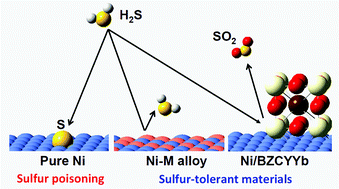From Ni-YSZ to sulfur-tolerant anode materials for SOFCs: electrochemical behavior, in situ characterization, modeling, and future perspectives
Abstract
Solid

* Corresponding authors
a
Center for Innovative Fuel Cell and Battery Technologies, School of Materials Science and Engineering, Georgia Institute of Technology, Atlanta, Georgia, USA
E-mail:
meilin.liu@mse.gatech.edu
Tel: +1-404-894-6114
b Department of Chemistry, National Taiwan Normal University, Taipei, Taiwan, ROC
c Department of Chemistry, Emory University, 1515 Dickey Drive, Atlanta, Georgia, USA
d Center for Interdisciplinary Molecular Science, National Chiao Tung University, Hsinchu, Taiwan, ROC
e World Class University (WCU), UNIST, South Korea
Solid

 Please wait while we load your content...
Something went wrong. Try again?
Please wait while we load your content...
Something went wrong. Try again?
Z. Cheng, J. Wang, Y. Choi, L. Yang, M. C. Lin and M. Liu, Energy Environ. Sci., 2011, 4, 4380 DOI: 10.1039/C1EE01758F
To request permission to reproduce material from this article, please go to the Copyright Clearance Center request page.
If you are an author contributing to an RSC publication, you do not need to request permission provided correct acknowledgement is given.
If you are the author of this article, you do not need to request permission to reproduce figures and diagrams provided correct acknowledgement is given. If you want to reproduce the whole article in a third-party publication (excluding your thesis/dissertation for which permission is not required) please go to the Copyright Clearance Center request page.
Read more about how to correctly acknowledge RSC content.
 Fetching data from CrossRef.
Fetching data from CrossRef.
This may take some time to load.
Loading related content
